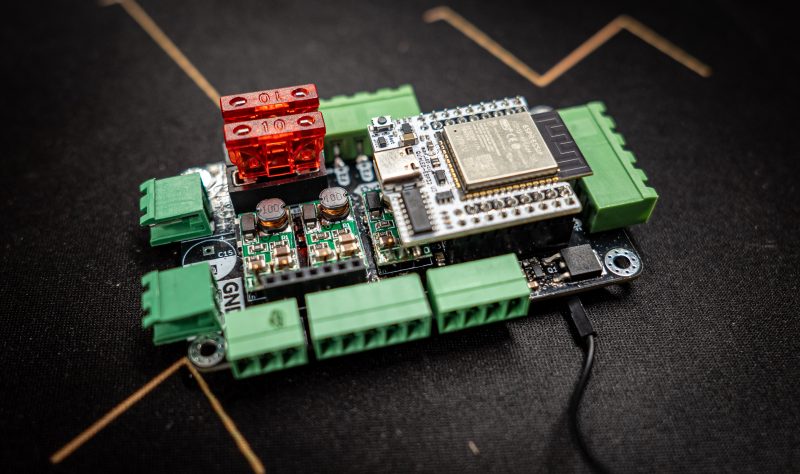QuinLED-An-Penta Specifications
Back to QuinLED-An-Penta-DIY index page
The QuinLED-An-Penta is an Analog LED dimmer/controller board which uses an ESP32 and PWM to control 5 LED channels. It’s built with high power handling for total and per channel in mind and does everything “the right way” including 12v MOSFET gate drivers, 2x replaceable fuses, handling up to 36v and a board current capacity of 15~20Amps with 10Amps max per channel. Some other special features include the ability to hook up the board through Ethernet, dedicated switch/button terminals, having a temperature/humidity sensor onboard (for board temp measurements, not room!) and an OLED screen*!
It can run either WLED or ESPhome and it’s the perfect companion for Home Assistant if you want to run 12v or 24v LED strips, either high quality (CRI) white LED strips, multiple (CCT) white strips, RGB, RGBW or even RGB+CCT or whatever combination the 5 channels allow for!
*OLED screen does not work correctly when combined with Ethernet
Features
Please read till end to see maximum power figures!
- Based on ESP32
- Specifically designed around QuinLED-ESP32
- Including AB (Antenna Board), AE (Antenna External) and ABE (Antenna board + Ethernet)
- Compatible with generic D1 Mini32
- Specifically designed around QuinLED-ESP32
- 5 channels for PWM LED dimming
- Uses 12v MOSFET gate drivers
- When using 12v LED strips, MOSFET gate drive will be ~10.5v
- Allows for large TO-252 MOSFET selection!
- Up to 300kHz PWM frequency
- Large TO-252 MOSFETs for high power handling per channel
- Optional SS36 “flyback/freewheeling” diode per channel
- Uses 12v MOSFET gate drivers
- 2x input ATO style input fuses
- Allows you to fuse power going to LED strips directly on the board
- 2 “channels” of fuses available for various setups
- Large Phoenix style pluggable terminals
-
- Compatible with normal screw terminals too!
- 2x Positive and 2x Negative input terminals (up to 14AWG)
- 4x Fused output terminals
- Easy wiring when using multiple strips
- Divided over the 2x fuses
- 5x Channel output terminals
-
- Supports 12v and 24v LED strips
- Can be used up to 36v!
- Onboard SHT31 I2C temperature & humidity sensor
- Can be used to monitor board temperature while in enclosure
- Extra GPIO Pins broken out as terminals
- 2x Terminals for I2C bus
- Connect more external I2C devices such as more temperature sensors, etc.
- 3x Terminals for input only connections
- Meant for connecting buttons/switches to the board
- Pulled High to 3.3v
- Hardware based de-bouncing network on board
- Meant for connecting buttons/switches to the board
- 2x Terminals GPIO pins (*Limitations apply when using Ethernet)
- 5v, 3.3v, 2x GND Terminals
- 2x Terminals for I2C bus
- Socket for SPI based OLED status screen
- *Cannot be used together with Ethernet
- If not used, extra GPIO pins can be used with DuPont cables!
- 4x M3 mounting holes
Power Handling
- Since this is a 4 layer board, power handling is based on 1OZ copper for all layers!
- All testing has been done with a 1OZ,1OZ,1OZ,1OZ version!
- For higher loads (above 10Amps total) please use both positive and negative input terminals with decent size wires to your power supply!
- The 2x onboard fuses can be used together with any of the 5 output channels
- When adding the SS36 “flyback/freewheeling” diode and running an inductive load feedback current will become important, please see board silkscreen for how the channels are divided!
Maximum per channel power
Maximum recommended power for a single channel is ~10Amps!
- Higher will make MOSFET heat up too much
- Output terminals also will heat up a lot with more then 10Amps current
Maximum total board power
The design goal of the board was to be able to fully utilize a Meanwell LRS-350-24 or the Meanwell UHP-350-24 (no fan, active PFC) which give you 350w of power so roughly 15Amps at 24v volt. If divided over multiple channels the board handles this without issue.
Maximum recommended power for total board is ~20Amps!
- Higher will make positive input terminals to heat up a lot!
- Fuses will heat up a lot running more then 10Amps a piece through them

